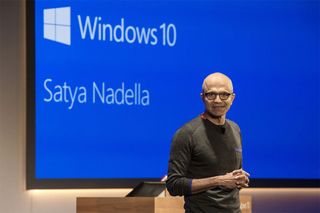Windows 10 climbs to 700 million devices en route to elusive 1 billion goal
'Only' 300 million more to go.

Just a few months prior to Windows 10's launch, Microsoft's Terry Myerson, then head of the company's operating system group, made an ambitious prediction—Windows 10 would reach 1 billion devices "in two to three years." Now just a little over three years later, Windows 10 is on 700 million devices, 300 million short of that original goal.
Microsoft offered up the updated the statistic at its Ignite 2018 conference earlier this week, Neowin reports. Myerson had previously said that Windows 10 was approaching the 700 million devices mark, making the statement back in March when announcing his departure from Microsoft. The last official figure was 600 million, back in November of last year. That means Windows 10 has expanded to 100 million more devices in the past 10 months. At the current pace, it will take another two and half years to reach 1 billion.
There's no way to know if the pace will stay the same, though. A lot of things can happen in 2-3 years. Starting in early 2020, for example, Microsoft will end support for 2020 and start charging businesses for security updates to Windows 7. That could potentially give Windows 10's footprint a boost.
It also remains to be seen what impact gaming will have on Windows 10's footprint. Microsoft's DirectX 12 API is not supported on earlier versions of Windows, and if ray tracing takes off the way Nvidia hopes it will, that could provide further incentive for gamers on older OSes to upgrade. It's worth noting that Microsoft's DirectX Raytracing (DXR) API is an extension of DX12.
The latest figures from Steam's monthly hardware and software survey show that Windows 10 is still making headway among gamers. As of the end of August, over 60 percent of Steam gamers are running Windows 10 64-bit, versus around 31 percent of Windows 7 users (32-bit and 64-bit combined). That's up from 54 percent a month prior.
We don't expect ray tracing to have an immediate impact on these figures. It's just too early—developers have to embrace ray tracing, and we still don't know how Nvidia's GeForce RTX cards will perform when they do. Pile on high asking prices (compared to GTX cards), and it's just not likely to be an overnight sensation.
Still, Nvidia and Microsoft are laying the groundwork, and it remains to be seen how AMD and even Intel, which is aiming to launch its first discrete GPU in 2020, will approach ray tracing. It's probably not a question of whether Windows 10 will hit 1 billion devices, but when.
The biggest gaming news, reviews and hardware deals
Keep up to date with the most important stories and the best deals, as picked by the PC Gamer team.
Paul has been playing PC games and raking his knuckles on computer hardware since the Commodore 64. He does not have any tattoos, but thinks it would be cool to get one that reads LOAD"*",8,1. In his off time, he rides motorcycles and wrestles alligators (only one of those is true).
Most Popular






